All emergency exit lights must be inspected monthly & should stay lit for at least 30 seconds. At least annually, battery-powered emergency lighting should be tested & stay lit for 1.5 hours. Emergency exit lighting must light the entire exit route, including the outside and along the path to safe refuge.
Emergency lighting should automatically come on when normal lighting fails. If it needs to switch to another power source, like battery power or generator power, it needs to do so within 10 seconds after the building power is lost. Battery powered emergency lighting must remain illuminated for at least 1.5 hours.
Emergency exit signs must be no more than 100 feet apart and employees must be able to see them all directions from the exit access.
Emergency exit lighting may not be the only emergency lighting that you need. Consider whether you may also need:
- Emergency area lighting. This type of emergency lighting illuminates the open areas so that workers can easily find their way to the nearest emergency exit.
- High risk area task lighting. This type of lighting illuminates processes that need to be shut down safely before the operator can leave.
 Consider placing lighting lower near the floor so that they may be seen in heavy smoke.
Consider placing lighting lower near the floor so that they may be seen in heavy smoke. The path to and from an emergency exit must always be free from obstructions and properly maintained to prevent trips and falls. The path must lead to a place of safe refuge away from vehicular traffic.

 RSS Feed
RSS Feed
